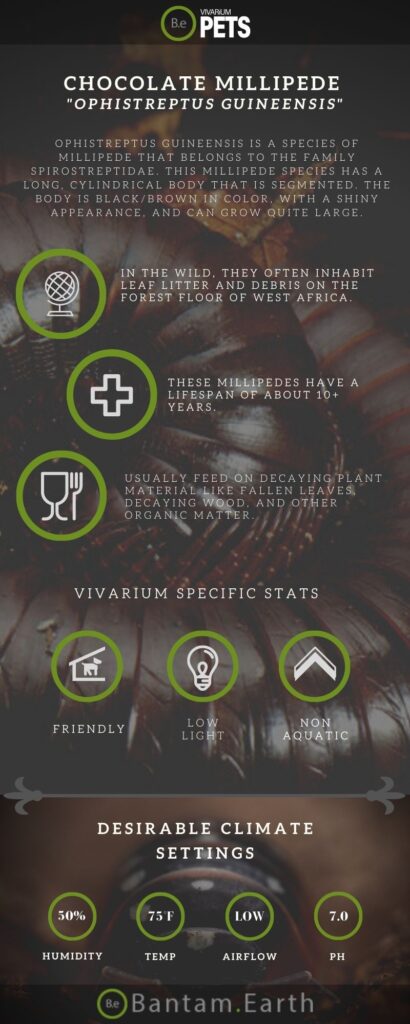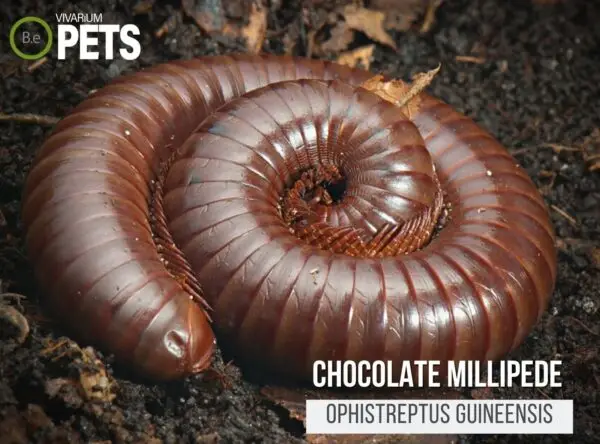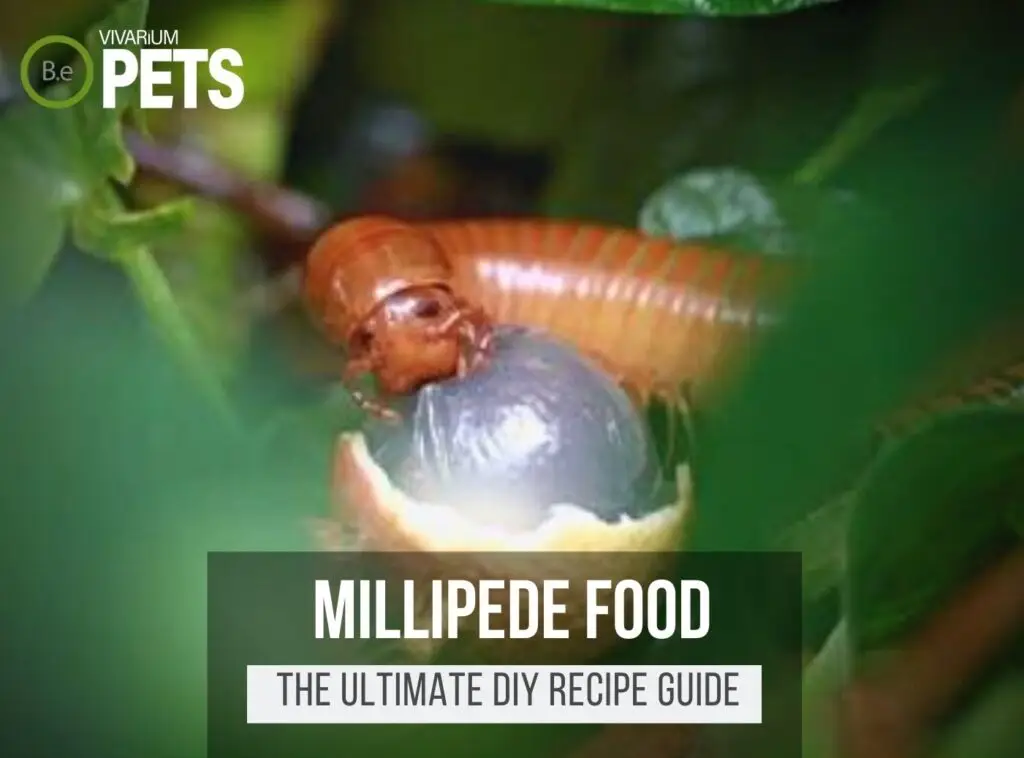Today, we are going to talk about Chocolate Millipedes (or Ophistreptus guineensis) and not as an edible arrangement but for vivarium keeping!
This care guide is designed to help those interested in learning (Not eating) about fostering this incredible species.
From understanding their habitat and diet to maintaining the proper environment and handling these fascinatingly large millipedes.
Let’s get started!
| Characteristics: | |
|---|---|
| Common Name | Chocolate Millipede |
| Family Name | Spirostreptidae |
| Scientific Name | Ophistreptus guineensis |
| Use | Cleaning, Aerating Soil, Pets |
| Temperament | Non-aggressive |
| Lifespan | 10+ Years |
| Diet | Detritivore |
| Adult Size | 22.86 cm |
| Breeding Type | Egg Layer |
| Care Level | Easy |
| Minimum Tank Size | 10-15 Gallons |
| pH | 6.5-7.5 |
| Hardness | Soft |
| Temperature | 70-85°F |
What Are Chocolate Millipedes?
Ophistreptus guineensis belong to the family Spirostreptidae, commonly known as Chocolate Millipedes.
They get their name from their chocolate-like color as well as the aroma they give off when handled.
They are sometimes kept as pets and are appreciated for their non-aggressive behavior and hardy nature.
What Do Chocolate Millipedes Look Like?
The Chocolate Millipede is mainly brown/black and is a relatively large species, growing up to 22.9 cm (9 inches) in length.
It has typically 19-21 body segments and a pair of antennae that is around the same length as its body, allowing it to feel the environment around it.
The millipede also possesses a pair of large eyes and a hard, shiny, segmented exoskeleton.
While the coloring may differ slightly between individuals and sexes, the distinct uniform coloring across its whole body sets it apart from most other species.
Benefits Of Using Chocolate Millipedes
Chocolate Millipedes provide many benefits when added to a vivarium.
They are a docile species and make an interesting addition to a tank, providing both entertainment and educational value.
Not only that, but they also play an important role in their environment by helping to aerate the soil, improve drainage, and aid in the decomposition of organic matter.
Furthermore, they act as a natural pest control, reducing the population of other unwanted small insects in the environment.


Chocolate Millipede Facts
Native to West Africa, Chocolate Millipedes are long, milk chocolate-colored arthropods mostly known for their distinctive hue and size.
They have a gentle temperament, and omnivorous diet, and can live for up to 10 years.
Captive breeding is more difficult but is possible by providing ideal conditions and separate tank and hibernation setups for a male and female.
Habitat
Chocolate Millipedes are native to West Africa, specifically, the countries of Ghana and Nigeria.
They inhabit a variety of habitats, including rainforests, dry savannas, and even semi-arid areas.
In the wild, they are often found scavenging around leaf litter and debris on the forest floor, which provides them with a steady food source and protection from the harsher elements.
Diet
In addition to the varied habitats they thrive in, Ophistreptus guineensis is quite an active and opportunistic feeder.
In their natural habitat, Chocolate Millipedes usually feed on decaying plant material like fallen leaves, decaying wood, and other organic matter.
They also feed upon a variety of fruits found in their natural habitats, as well as fungi, carrion, and smaller millipedes.
Furthermore, they are partial to fermented fruits, allowing them to acquire various nutrients and amino acids.
Temperament
The Chocolate Millipede is known to be gentle and generally not aggressive toward humans and other animals.
While they may be quick to curl up and run away when touched, they are not typically known to bite if handled with care.
They will usually stay still when touched. They are also known to make a gentle clicking sound which can be heard when they are curious or surprised.
In addition, Ophistreptus guineensis are non-venomous, which makes them a great pet for beginner owners.
They tend to be timid and prefer to hide or curl up when in direct contact with humans.
However, when handled consistently and with care, Chocolate Millipedes can become more accustomed to regular contact.
With patience and practice, they can develop a trusting relationship with their owner.
It is important to note that Chocolate Millipedes do best on their own and do not require any other animals or pets.
Lifespan
Ophistreptus guineensis is expected to live for between 8 to 10 years in captivity depending on the care given and its environment.
These fascinating creatures will go through three life stages before reaching adulthood.
The first stage is an egg, which is laid by the female in moist soil.
It will then hatch into a mini juvenile form, which will molt through several instars before becoming a fully-grown adult.
During this time the millipede will double in size to reach its full adult length.
In the wild, their lifespan may be even shorter due to predators, living conditions, and other threats.
Breeding
Chocolate Millipedes have a unique form of mating and reproduction.
A single male will court several females by using both visual and audio cues.
When a female accepts his advances, the pair will intertwine their bodies while the male releases a special pheromone.
It is this pheromone which triggers the release of eggs in the female.
The female will then secure her eggs in small, well-protected areas.
Despite being small, these eggs are surprisingly resilient and will hatch in just a few weeks.
At around three weeks old, the baby chocolate millipedes are independent and able to care for themselves.
Owners need to make sure that the environment has enough food and other necessary supplies to ensure their health as they grow.
Where To Find Chocolate Millipedes
Finding a Chocolate Millipede can be both exciting and intimidating.
When searching for a wild Ophistreptus guineensis, you should look in areas with damp soil and plentiful vegetation.
Popular locations include tropical and subtropical rainforests, as well as grasslands and agricultural areas.
They often hide in leaf litter and can be uncovered in a careful search.
If you’d prefer to purchase a Chocolate Millipede, they are available from a variety of breeders and pet stores.
They aren’t as common as other pet species, so they may be difficult to find.
Chocolate Millipede Care
Ophistreptus guineensis require a specific environment to thrive.
They should be housed in an enclosure with appropriate temperature, humidity, and lighting, and fed a balanced diet of foods.
They should be handled delicately, and their substrate should be cleaned regularly to maintain optimal health.
With proper care and attention, your Chocolate Millipede can live a long and healthy life.
Tank Requirements
The ideal tank for a Chocolate Millipede should be a tropical terrarium or paludarium with a tight-fitting lid, as they are fairly good climbers.
The ideal enclosure should be at least 10 gallons in size with plenty of room for burrowing.
The ideal temperature range for them is between 24-28 degrees Celsius and should include a low-voltage terrarium lighting source.
The terrarium substrate should ideally be a mixture of coconut fiber, and peat moss and should be kept slightly moist.
Additionally, a shallow bowl of water with a humidity rind must be provided as well.
Finally, terrarium decoration and hide-aways should not be overlooked as these will help your pet feel safe and secure in their new home.
What Do Chocolate Millipedes Eat?
Feeding Chocolate Millipedes can be easy and fun!
It’s important to provide them with varied and nutritionally complete diets to maintain their health and well-being.
Here are some food sources that are suitable to feed Ophistreptus guineensis :
- Fresh Fruits and Vegetables: Most fruits and vegetables make a great meal for your millipedes, such as apples, pears, melons, grapes, spinach, carrots, squash, etc.
- High-Nutrition Foods: Foods such as mealworms, oatmeal, bread, fish flakes, and other high-nutrition food sources are great for more variety in their diet and to provide occasional treats.
- Plant Materials: Plant materials such as dried leaves, flowers, and bark provide a nutritious, if slightly less interesting, meal.
When feeding your Chocolate Millipedes, remember to provide a variety of food sources and feed them in moderation.
Also avoid giving your millipedes any food that is salty, sweet, acidic, or spoiled as these can be particularly harmful to them.
If you’re more of an avid hobbyist like myself, be sure to check out my ultimate DIY Millipede food guide. I give a more in-depth explanation of the best foods and my favorite recipe.
Best Tankmates For Chocolate Millipedes
Unfortunately, Chocolate Millipedes cannot be kept with many other species, so it is important to select a tank mate carefully.
Luckily, some very friendly and compatible animals can live happily alongside Ophistreptus guineensis.
Springtails are a great tank mate for Chocolate Millipedes.
These tiny arthropods are harmless, non-aggressive, and peaceful, and they can be very beneficial for your millipede.
Springtails help to deal with decaying organic matter, providing a natural clean-up crew in the enclosure.
In addition, they produce strong shed material, which the millipedes can easily consume and use for nutrition.
Mealworms and Waxworms are other excellent tank mates for Chocolate Millipedes.
These larvae are packed with nutrients, and provide an excellent source of food for your pet.
While these two species can sometimes be aggressive, they pose no threat to millipedes since they live on the ground.
It is important to make sure they are healthy before introducing them to the enclosure.
Snails and isopods can also be very beneficial tankmates for Chocolate Millipedes.
These animals are great additions to any millipede tank, as they break down decaying matter, consume uneaten food, and clean up after the millipede.
Conclusion
Congratulations! By making it to the end of this Ophistreptus guineensis care guide, you are now fully equipped with the knowledge needed to properly care for your Chocolate Millipedes.
Remember to always provide a clean, safe, and well-maintained habitat as well as a healthy diet and manage the environment to suit their needs.
With enough patience and love, you can provide these pet millipedes with the long and happy life that they deserve.
Frequently Asked Questions
Chocolate millipedes have a lifespan of about 10-plus years in captivity.
However, in the wild, their lifespan may be shorter due to various environmental factors such as predators, disease, and availability of food and water.
Chocolate millipedes are detritivores, which means they feed on decaying plant matter such as fallen leaves and wood. They can also eat fruits and vegetables.

